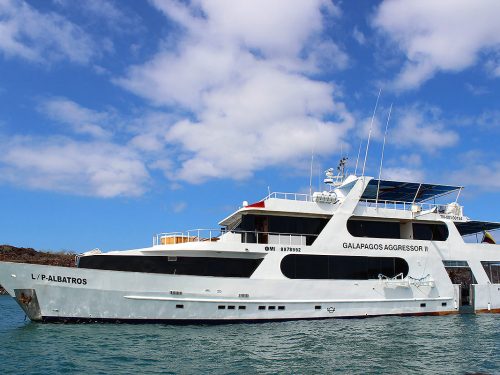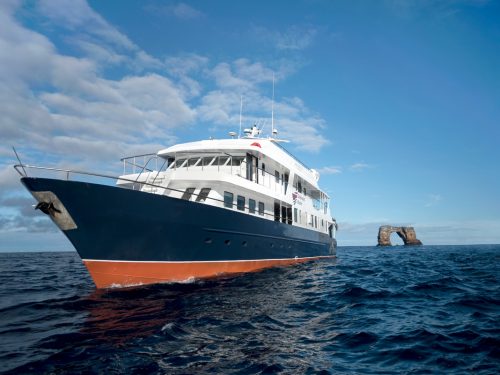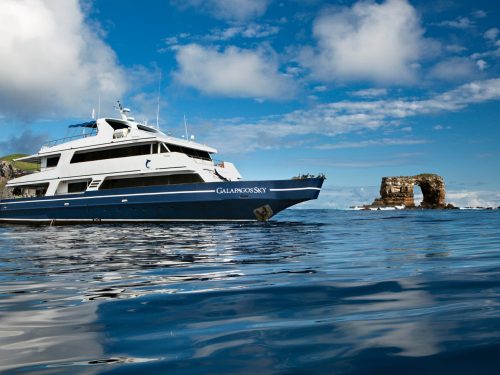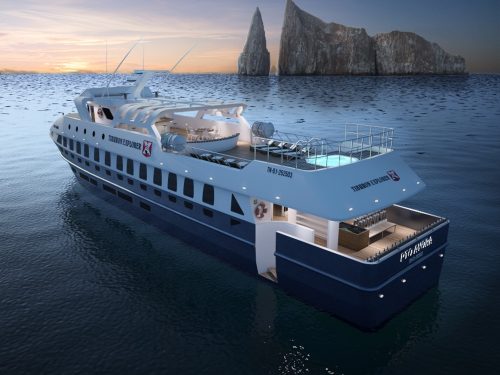By Land Or By Liveaboard
Depending on the season, massive groups of hammerhead sharks, multiple species of rays, and the magnificent whaleshark are all commonly sighted among the Galapagos, particularly around some of the more remote dive sites like Wolf Island and Darwin Island.
Drift dives, deep dives, and reef dives are all part of the Galapagos experience, and thanks to the islands’ tropical location, scuba diving is exciting and accessible all year long. While land-based diving is widely available in and around the islands, many of the best sites for shark action and seasonal sightings (think: whaleshark) can only be reached by liveaboard.
The three major ocean currents that converge in the Galapagos bring an incredible mix of marine life to the region, but the resulting surges and downdrafts do mean that many of the dive sites can be quite challenging for divers with less experience. Specifically, the sites accessed by most liveaboards, including Darwin and Wolf Islands, are best enjoyed by more seasoned divers.
Pelagics Plus
Land-based divers shouldn’t be surprised to find themselves swimming in the company of the region’s many penguins, sea lions, and sea turtles, or with the endemic marine iguana – the only lizard that actually swims in the ocean. Dozens of species of fish of every size, shape and colour imaginable are found in the Galapagos, from grunts and groupers, to rainbow basslets and red-lipped batfish.
The bubbling fumaroles of the underwater volcano at Roca Redonda, off Isabela Island, provide the perfect prehistoric backdrop for encounters with white-tip sharks, mantas, and the Galapagos grunt. Meanwhile, divers at Pitt Point off San Cristobal Island are sometimes lucky enough to see as many as three different species of boobies diving for the large schools of snappers and jacks that hang out around this enormous, exposed rock.
When it comes to both size and numbers, Darwin’s Arch off Darwin Island is arguably the best site in the Galapagos. Divers will enjoy seemingly endless encounters with turtles, Galapagos sharks, tiger sharks, moray eels, and eagle rays, while the majestic whaleshark and vast schools of hammerheads silently patrol the blue around them. At Wolf Island, the throngs of hammerheads number in the hundreds. The clicks and whistles of passing dolphins are common at this site, and Galapagos sharks and silkies, eagle rays and mobulas, Bluefin tuna, turtles, and thousands of reef fish all jostle for position here.
What To Do When You’re Not Diving Galapagos
Even the most die-hard diver has to come out of the water some time. Fortunately, the natural beauty of the Galapagos is just as compelling by land as it is by sea. As one of the world’s foremost destinations for wildlife-viewing, many of the plants and animals here are found nowhere else on the planet.
Visitors can make friends with a hundred-year old Galapagos tortoise, explore the lava tubes of Santa Cruz, or hike the Alcedo volcano. Many travelers take the opportunity to combine their scuba diving vacation with a mainland excursion to Peru’s Machu Picchu, or a chance to explore the incredible Amazon Basin.
The Best Time To Go
Regular flights service both Baltra and San Cristobal Islands from Guayaquil and Quito in Ecuador. In terms of visitors, things are much quieter in the Galapagos from December through May, but this rainy season brings frequent sunshine punctuated by intense daily showers. Divers who don’t mind the rain are rewarded by warmer waters, calmer seas, and great opportunities to encounter large groups of eagle rays, mobula rays, and mantas.
While the months of June through November are drier in the Galapagos, diving at this time of year means colder water temperatures and higher winds. This is a small price to pay, however, for the solid chance of a close-up encounter with the incomparable whalesharks that migrate through the region from July to October.
Getting There
To get to the Galapagos Islands one needs to fly to mainland Ecuador first (either Quito or Guayaquil) and connect from there to either San Cristobal or Baltra on Santa Cruz. This also means that you can combine a trip to the Galapagos with some great options in Ecuador: explore the Amazon basin, the colorful Indian Markets, the mountainous regions or why not add on a trip to Peru’s Machu Picchu?
Click here to read more about what Ecuador has to offer.










